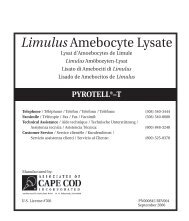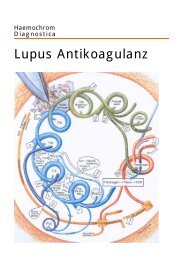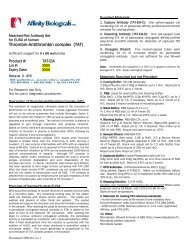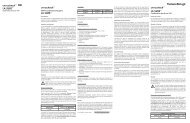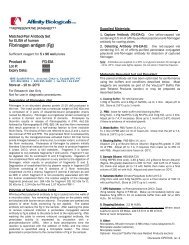Limulus Amebocyte Lysate - Associates of Cape Cod, Inc.
Limulus Amebocyte Lysate - Associates of Cape Cod, Inc.
Limulus Amebocyte Lysate - Associates of Cape Cod, Inc.
Create successful ePaper yourself
Turn your PDF publications into a flip-book with our unique Google optimized e-Paper software.
<strong>Limulus</strong> <strong>Amebocyte</strong> <strong>Lysate</strong><br />
Manufactured by:<br />
®<br />
CHROMO-LAL<br />
Telephone: (508) 540-3444<br />
Toll-Free: (888) 395-2221<br />
Fax: (508) 540-8680<br />
Technical Support: (800) 848-3248<br />
Customer Service: (800) 525-8378<br />
US License # 700 PN001087 Rev000 November 2007<br />
LIMULUS AMEBOCYTE LYSATE<br />
CHROMO-LAL<br />
for the Detection and Quantitation <strong>of</strong> Gram Negative<br />
Bacterial Endotoxins (Lipopolysaccharides)<br />
SUMMARY AND EXPLANATION OF TEST<br />
In the 1950's, Frederik Bang observed that infection from<br />
gram negative bacteria resulted in intravascular coagulation<br />
in <strong>Limulus</strong> polyphemus, the horseshoe crab (1). Levin<br />
and Bang demonstrated that the coagulation was caused<br />
by the activation <strong>of</strong> a number <strong>of</strong> enzymes located in the<br />
blood cells (amebocytes) <strong>of</strong> <strong>Limulus</strong> polyphemus, and that<br />
this activation was initiated by the endotoxin (lipopolysaccharide)<br />
in the gram negative bacterial cell walls (2, 3, 4).<br />
Subsequently, the <strong>Limulus</strong> <strong>Amebocyte</strong> <strong>Lysate</strong> (LAL) test<br />
using LAL reagent prepared from horseshoe crab blood<br />
was shown to be the most sensitive and specific means <strong>of</strong><br />
measuring bacterial endotoxins (5). The chromogenic test,<br />
introduced in 1977 (6, 7), is a modification that enables<br />
endotoxin concentration to be measured as a function <strong>of</strong><br />
color intensity rather than by turbidity or gelation in the<br />
reaction mixture. Results obtained by this modified<br />
method are generally comparable to those obtained by the<br />
gel-clot or turbidimetric methods within the error <strong>of</strong> the<br />
tests.<br />
In the Chromo-LAL test, co-lyophilized LAL and substrate<br />
reagent are mixed with test sample in a microplate and<br />
incubated in a reader at 37±1°C. Absorbance measurements<br />
are collected with time after addition <strong>of</strong> Chromo-<br />
LAL and analyzed by suitable s<strong>of</strong>tware. The time (onset<br />
time) taken for a sample to reach a specified absorbance<br />
(onset OD) is calculated; and a standard curve, showing<br />
the linear correlation between the log onset time and the<br />
log concentration <strong>of</strong> standard endotoxin, is generated. The<br />
maximum range <strong>of</strong> endotoxin concentrations for the standard<br />
curve is 0.005 EU/mL - 50 EU/mL. The sensitivity ( λ)<br />
<strong>of</strong> the assay is defined as the lowest concentration used in<br />
the standard curve. The maximum sensitivity <strong>of</strong> this test is<br />
0.005 EU/mL.<br />
BIOLOGICAL PRINCIPLE<br />
LAL contains enzymes that are activated in a series <strong>of</strong><br />
reactions in the presence <strong>of</strong> endotoxin. The last enzyme<br />
activated in the cascade splits the chromophore, paranitro<br />
aniline (pNA), from the chromogenic substrate,<br />
producing a yellow color.<br />
Endotoxin<br />
1. Proenzyme Enzyme<br />
Enzyme<br />
2. Chromogenic Substrate Peptide + pNA<br />
The amount <strong>of</strong> pNA released and measured photometrically<br />
at 405 nm is proportional to the amount <strong>of</strong> the endotoxin<br />
in the system. The greater the endotoxin concentration,<br />
the faster the reaction.<br />
.<br />
REAGENTS<br />
Reagents required to perform the Chromo-LAL Assay are<br />
listed below. Unopened reagents are stable at 2-8°C until<br />
the expiration date printed on the container label. Before<br />
reconstitution, bring the reagents to room temperature<br />
and tap the vials containing lyophilized material against a<br />
hard surface to cause loose material to fall to the bottom <strong>of</strong><br />
the vial.<br />
1. Chromo-LAL, <strong>Limulus</strong> <strong>Amebocyte</strong> <strong>Lysate</strong> colyophilized<br />
with chromogenic substrate<br />
This reagent is an aqueous extract <strong>of</strong> amebocytes <strong>of</strong> L.<br />
polyphemus, buffered at pH 7, and co-lyophilized with<br />
the chromogenic substrate. Reconstitute Chromo-LAL<br />
immediately before use with 3.2 mL LAL Reagent Water<br />
(LRW). This solution is stable 24 hours at 2-8°C or for<br />
two weeks at -20°C or colder if frozen immediately after<br />
reconstitution and not contaminated. Chromo-LAL<br />
may be frozen and thawed once. Contamination may<br />
be indicated by a dark yellow color that develops rapidly<br />
after reconstitution. The reagent will turn yellow<br />
slowly under normal conditions <strong>of</strong> use.<br />
2. Control Standard Endotoxin (CSE)<br />
Control Standard Endotoxin (CSE) is not provided<br />
with Chromo-LAL and must be ordered separately.<br />
CSE obtained from <strong>Associates</strong> <strong>of</strong> <strong>Cape</strong> <strong>Cod</strong>, <strong>Inc</strong>., is<br />
used to construct standard curves, validate product,<br />
and prepare inhibition controls. Each vial contains a<br />
measured weight <strong>of</strong> endotoxin. USP Endotoxin<br />
Reference Standard may be obtained from the U.S.<br />
Pharmacopeial Convention, <strong>Inc</strong>. Follow manufacturer’s<br />
directions for reconstitution and storage <strong>of</strong> standard<br />
endotoxins. CSE lots may show different potencies<br />
(EU/ng) when tested with different lots <strong>of</strong> Chromo-<br />
LAL. If using CSE, endotoxin concentrations can be<br />
expressed in EU/mL if the potency <strong>of</strong> a given lot <strong>of</strong><br />
CSE has been determined with the Chromo-LAL lot in<br />
question. (11,12).<br />
3. LAL Reagent Water (LRW)<br />
LRW is sterile water prepared by distillation or reverse<br />
osmosis that shows no detectable endotoxin when<br />
tested with Chromo-LAL. Additional vials <strong>of</strong> LRW<br />
may be obtained from <strong>Associates</strong> <strong>of</strong> <strong>Cape</strong> <strong>Cod</strong>, <strong>Inc</strong>.<br />
Precautions and Warnings: Chromo-LAL is for in vitro<br />
diagnostic use only. Do not use these reagents for the<br />
detection <strong>of</strong> endotoxemia. Exercise caution when handling<br />
Chromo-LAL reagent because its toxicity has not<br />
been determined and allergies to LAL have been reported<br />
(8). Correct application <strong>of</strong> this test requires strict adherence<br />
to all items in the recommended procedure. Aseptic<br />
technique must be used. All materials coming in contact<br />
with specimens and reagents must be free <strong>of</strong> detectable<br />
endotoxin. Heat stable materials, including clean glassware,<br />
may be rendered free <strong>of</strong> detectable endotoxin by<br />
exposure to dry heat at a minimum temperature <strong>of</strong> 250°C<br />
for a minimum <strong>of</strong> 30 minutes (9).<br />
SPECIMEN COLLECTION AND PREPARATION<br />
Collect samples in a way that avoids microbial contamination.<br />
Use aseptic technique when handling specimens and<br />
reagents. Test any samples as soon as possible after collection;<br />
otherwise store them at 2-8°C. If bacterial growth is<br />
expected, samples may be frozen. Confirm that storage<br />
does not reduce the level <strong>of</strong> endotoxin detectable in the<br />
sample (endotoxin may adsorb to the container surface).<br />
Many substances interfere with the Chromo-LAL test.<br />
Interference is indicated by inhibition, the recovery <strong>of</strong> less<br />
endotoxin than known to be present in a sample; or by<br />
enhancement, the recovery <strong>of</strong> more endotoxin than the<br />
amount known to be present (see "Procedure" for detection<br />
<strong>of</strong> interference). Interference is generally overcome by<br />
diluting the sample with LAL Reagent Water. Do not dilute<br />
beyond the Maximum Valid Dilution (MVD; 10, 11, 12, 13).<br />
MVD =<br />
endotoxin limit x product concentration<br />
Certain compounds may need special treatment in addition<br />
to dilution to remove interference. For example,<br />
blood products containing activated enzymes may cause<br />
false positive results. These types <strong>of</strong> samples may be<br />
diluted with LAL Reagent Water and heated at a minimum<br />
temperature <strong>of</strong> 75°C for a period <strong>of</strong> time shown to eliminate<br />
interference without loss <strong>of</strong> endotoxin activity.<br />
Samples that absorb strongly at 405 nm may interfere<br />
with the test and may require prior dilution.<br />
TEST PROCEDURE<br />
Reagents required to perform the Chromo-LAL Assay are<br />
listed under reagents.<br />
Equipment and materials required but not provided:<br />
1. Test tubes and/or microplates free <strong>of</strong> detectable endotoxin.<br />
Both available through <strong>Associates</strong> <strong>of</strong> <strong>Cape</strong> <strong>Cod</strong>,<br />
<strong>Inc</strong>.<br />
2. Pipettes and pipette tips that are free <strong>of</strong> detectable<br />
endotoxin. Available through <strong>Associates</strong> <strong>of</strong> <strong>Cape</strong> <strong>Cod</strong>,<br />
<strong>Inc</strong>..<br />
3. Repetitive pipettes with dispensing syringes free <strong>of</strong><br />
detectable endotoxin.<br />
4. Vortex mixer.<br />
5. Microplate reader equipped with suitable<br />
.<br />
s<strong>of</strong>tware and<br />
capable <strong>of</strong> maintaining a uniform temperature across<br />
the microplate <strong>of</strong> 37±1°C. Available through <strong>Associates</strong><br />
<strong>of</strong> <strong>Cape</strong> <strong>Cod</strong>, <strong>Inc</strong>.<br />
6. Kinetic s<strong>of</strong>tware. S<strong>of</strong>tware that collects and stores optical<br />
density (OD) readings at short intervals is necessary.<br />
The s<strong>of</strong>tware must also calculate ¨onset time¨ for the<br />
sample in each well. An onset time is the time taken<br />
for the OD in a given well to reach a specified OD value<br />
(onset OD). The chosen value may be between 0.03<br />
and 0.2 OD units; however the same value should be<br />
used for routine testing as was used for the validation<br />
<strong>of</strong> the assay for that product.<br />
λ<br />
The s<strong>of</strong>tware should generate the standard curve<br />
parameters (slope, intercept, and correlation coefficient)<br />
and calculate the endotoxin concentrations in<br />
the unknown samples. The s<strong>of</strong>tware may perform<br />
additional calculations such as calculating the concentration<br />
<strong>of</strong> the endotoxin recovered in the positive<br />
product control after subtraction <strong>of</strong> any endogenous<br />
endotoxin in the sample.
Standard curve<br />
<strong>Inc</strong>lude a standard curve consisting <strong>of</strong> at least three concentrations<br />
<strong>of</strong> endotoxin, in duplicate, with each set <strong>of</strong><br />
test samples. Additional concentrations should be added<br />
such that there is at least one standard per log increment<br />
<strong>of</strong> the range (11). Prepare the standard endotoxin concentrations<br />
by serial dilution starting with the highest or<br />
"stock" concentration. Mix the stock concentration<br />
approximately 30 seconds with a vortex mixer before<br />
making the first transfer.<br />
Any dilution scheme may be used to prepare standard<br />
endotoxins and the concentrations used to construct the<br />
curve may encompass any range within the limits <strong>of</strong><br />
0.005 to 50 EU/mL. The lowest concentration retained in<br />
the curve is the sensitivity ( λ) <strong>of</strong> the assay.<br />
An example <strong>of</strong> the preparation <strong>of</strong> a broad range series<br />
with λ equal to 0.005 EU/mL is given in the table below.<br />
Standard LAL Reagent Endotoxin Standard<br />
Concentrations Water (uL) Solution<br />
EU/mL<br />
50 950 50 ∝L <strong>of</strong> the stock solution<br />
5 900 100 ∝L <strong>of</strong> the 50 EU/mL solution<br />
0.5 900 100 ∝L <strong>of</strong> the 5 EU/mL solution<br />
0.05 900 100 ∝L <strong>of</strong> the 0.5 EU/mL solution<br />
0.005 900 100 ∝L <strong>of</strong> the 0.05 EU/mL solution<br />
Neg. Contr. 1000<br />
An archived standard curve (11,12) is not recommended.<br />
The parameters <strong>of</strong> the curve will change with the time<br />
after reconstitution <strong>of</strong> the reagent. Therefore, endotoxin<br />
standard concentrations should be included with each<br />
test.<br />
Negative control<br />
Negative controls, in duplicate, should be included with<br />
every set <strong>of</strong> samples. The negative control is the LRW<br />
used to dilute the samples for the test. The onset time <strong>of</strong><br />
the negative control should be at least 10% greater than<br />
that <strong>of</strong> the least concentrated standard. Once the characteristic<br />
performance <strong>of</strong> the negative control is known, the<br />
operator may stop the assay before the preset run time is<br />
completed (see ¨Assay Performance Time¨ below). Stop<br />
the assay only if it can be concluded, from visual inspection<br />
<strong>of</strong> the reaction kinetics, that the lowest concentration<br />
<strong>of</strong> standard has reached the onset OD and that the<br />
OD <strong>of</strong> the negative control is characteristically low.<br />
Detection <strong>of</strong> interference<br />
A sample to which a known amount <strong>of</strong> endotoxin standard<br />
is added (spiked sample) is referred to as a positive<br />
product control; this control for detection <strong>of</strong> inhibition or<br />
enhancement is included in a routine test protocol. By<br />
comparing the recovery <strong>of</strong> the endotoxin concentration<br />
in the positive product control with the concentration<br />
known to have been added, it is possible to determine<br />
whether the sample inhibits (less endotoxin is detected<br />
than is present) or enhances (more endotoxin is detected<br />
than is present) the assay.<br />
The calculated mean concentration <strong>of</strong> added endotoxin<br />
(concentration in the spiked sample minus the concentration<br />
in the sample) must be within 50% to 200% <strong>of</strong> the<br />
expected spike concentration to show that the product<br />
neither inhibits nor enhances the assay.<br />
The concentration chosen for the spike will depend on the<br />
range <strong>of</strong> the standard curve and on the endotoxin limit for<br />
the dilution or concentration <strong>of</strong> sample under test<br />
(pass/fail cut<strong>of</strong>f, 11).<br />
The spike concentration should be one <strong>of</strong> the concentrations<br />
used in the standard curve and should fall near the<br />
middle <strong>of</strong> the standard range. For the broad range curve<br />
illustrated above and with samples that have a pass/fail<br />
cut<strong>of</strong>f less than or equal to 1 EU/mL, an endotoxin concentration<br />
<strong>of</strong> 0.5 may be chosen. For the same range <strong>of</strong><br />
standards and with samples that have a pass/fail cut<strong>of</strong>f<br />
greater than 1 EU/mL, as much as 5.0 EU/mL may be<br />
chosen. For narrower ranges <strong>of</strong> standard concentrations,<br />
for example from 0.005 to 1.6 EU/mL a 4λ<br />
concentration or<br />
0.02 EU/mL would be more appropriate, especially if the<br />
pass/fail cut<strong>of</strong>f is much lower than 1 EU/mL.<br />
Assay<br />
1. Bring samples and controls to room temperature. Mix<br />
each vigorously on a vortex mixer immediately before<br />
transfer to the microplate well(s).<br />
2. Transfer 100 µL <strong>of</strong> sample or control to the microplate.<br />
3. Preincubate the microplate at 37±1°C for at least 10<br />
minutes.<br />
4. Reconstitute the Chromo-LAL reagent with 3.2 mL LAL<br />
Reagent Water or Glucashield TM Buffer.<br />
5. Transfer 100 µL <strong>of</strong> reconstituted Chromo-LAL reagent<br />
to each well as rapidly as possible by using a repetitive<br />
pipette.<br />
6. Mix thoroughly without splashing reaction mixture; this<br />
is an option in some readers.<br />
7. Place the microplate immediately in the microplate<br />
incubator/reader that has been set to read at 405 nm<br />
and incubate at 37±1°C. Start the kinetic s<strong>of</strong>tware.<br />
Assay performance time<br />
The time needed to complete the reaction depends on the<br />
range <strong>of</strong> endotoxin concentrations chosen for the standard<br />
curve and on lot specific characteristics. The "run time",<br />
using an onset OD <strong>of</strong> 0.05, is typically set for 60 minutes<br />
for an assay sensitivity <strong>of</strong> 0.05 EU/mL or for 100 minutes<br />
for a sensitivity <strong>of</strong> 0.005 EU/mL.<br />
RESULTS<br />
The endotoxin concentration for the corresponding onset<br />
time <strong>of</strong> the unknown sample is read from the standard<br />
curve which is a log-log plot <strong>of</strong> the onset times vs. the<br />
standard concentrations, or an arithmetic plot <strong>of</strong> the logs<br />
<strong>of</strong> onset times vs. the logs <strong>of</strong> the standard concentrations.<br />
A typical standard curve is illustrated below.<br />
The log-log line equation generated for the illustrated<br />
standard curve is Y= -0.2X + 3.14, where Y = log onset time<br />
and X = log endotoxin concentration. The concentration<br />
<strong>of</strong> endotoxin in an unknown sample with a mean onset<br />
time <strong>of</strong> 1630 seconds would be calculated by converting<br />
the onset time to its log value, 3.212, solving the equation<br />
for X, and taking the antilog <strong>of</strong> X to obtain concentration:<br />
X = (Y-3.14)/-0.2<br />
X = (3.212 - 3.14)/-0.2<br />
X = -0.36<br />
Antilog (-0.36) = 0.44 EU/mL<br />
LIMITATION OF THE PROCEDURE<br />
The procedure is limited by the extent <strong>of</strong> the inhibition or<br />
enhancement demonstrated by the test sample. If the<br />
interference can not be overcome by dilution or other<br />
means at the MVD, then the Chromo-LAL assay cannot be<br />
used to measure endotoxin in that sample.<br />
EXPECTED VALUES<br />
Endotoxin in the test sample can be quantified between<br />
the range <strong>of</strong> the endotoxin concentrations used to construct<br />
the standard curve. In order to report results in<br />
endotoxin units (EU) or international units (IU) <strong>of</strong> endotoxin,<br />
it is necessary to use either the standard reference<br />
endotoxin (e.g. USP endotoxin RS; EP endotoxin standard<br />
BRP) or a control standard with potency calibrated against<br />
the reference.<br />
If it is necessary to dilute the test sample to overcome inhibition<br />
or enhancement, the least amount <strong>of</strong> endotoxin that<br />
can be detected will be increased accordingly.<br />
PERFORMANCE CHARACTERISTICS<br />
The linearity <strong>of</strong> the standard curve, within the concentration<br />
range used to determine endotoxin levels, must be<br />
verified by performing the test on the appropriate number<br />
<strong>of</strong> standard concentrations (see curve above) in triplicate<br />
(11). Calculate the standard curve parameters without<br />
averaging the onset times <strong>of</strong> replicates. The absolute value<br />
<strong>of</strong> the coefficient <strong>of</strong> correlation, r, should be greater than<br />
or equal to 0.980. The same criterion for linearity applies<br />
to the standard curves that are included with routine tests<br />
(see standard curve above).<br />
REFERENCES<br />
1. Bang, F.B. The toxic effect <strong>of</strong> a marine bacterium on<br />
<strong>Limulus</strong> and the formation <strong>of</strong> blood clots. Biol. Bull.<br />
(Woods Hole, MA) 105:361-362 (1953).<br />
2. Levin, J., and F.B. Bang. A description <strong>of</strong> cellular coagulation<br />
in the <strong>Limulus</strong>. Bull. Johns Hopkins Hosp.<br />
115:337-345 (1964).<br />
3. Levin, J., and F.B. Bang. The role <strong>of</strong> endotoxin in the<br />
extracellular coagulation <strong>of</strong> <strong>Limulus</strong> blood. Bull. Johns<br />
Hopkins Hosp. 115:265-274 (1964).<br />
4. Levin, J., and F.B. Bang.1968. Clottable protein in<br />
<strong>Limulus</strong>: its localization and kinetics <strong>of</strong> its coagulation<br />
by endotoxin. Thromb. Diath. Haemorrh. 19: 186-197.<br />
5. Hochstei, H.D. 1987. The LAL test versus the rabbit<br />
pyrogen test for endotoxin detection: Update >87.<br />
Pharm. Technol. 11(6):124-129.<br />
6. Nakamura, S., T. Morita, S. Iwanaga, M. Niwa, and K.<br />
Takahashi. 1977. A sensitive substrate for the clotting<br />
enzyme in horseshoe crab hemocytes. J. Biochem.<br />
81:1567-1569.<br />
7. Iwanaga, Morita, Harada, Nakamura, Niwa, Takada,<br />
Kimura, and Sakakibara. 1978. Chromogenic Substrates<br />
for Horseshoe Crab Clotting Enzymes Its application<br />
for the assay <strong>of</strong> Bacterial Endotoxins. Haemostasis 7:<br />
183-188.<br />
8. Ebner, C., D. Kraft, F. Prasch, R. Steiner, and H. Ebner.<br />
Type I allergy induced by <strong>Limulus</strong> <strong>Amebocyte</strong> <strong>Lysate</strong><br />
(LAL). Clinical and Experimental Allergy 22:417-419<br />
(1992).<br />
9. Tsuji, K. and S.J. Harrison. Dry-heat destruction <strong>of</strong><br />
lipopolysaccharide: Dry-heat destruction kinetics.<br />
Appl. Env. Microbiol. 36:710-714 (1978).<br />
10. Bacterial Endotoxins Test. USP current revision,<br />
United States Pharmacopeial Convention,<br />
Rockville, MD.<br />
11. Interim Guidance for Human and Veterinary Drug<br />
Products and Biologicals. U.S. Department <strong>of</strong> Health<br />
and Human Services, Public Health Service, Food and<br />
Drug Administration. July 15 (1991).<br />
12. Guideline on Validation <strong>of</strong> the <strong>Limulus</strong> <strong>Amebocyte</strong><br />
<strong>Lysate</strong> Test as an End-Product Endotoxin Test for<br />
Human and Animal Parenteral Drugs, Biological<br />
Products, and Medical Devices. U.S. Department <strong>of</strong><br />
Health and Human Services, Public Health Service,<br />
Food and Drug Administration, December (1987).<br />
13. European Pharmacopoeia, current revision , Section<br />
2.6.14. Bacterial Endotoxins. European Pharmacopoeia<br />
Secretariat, Strasbourg.




